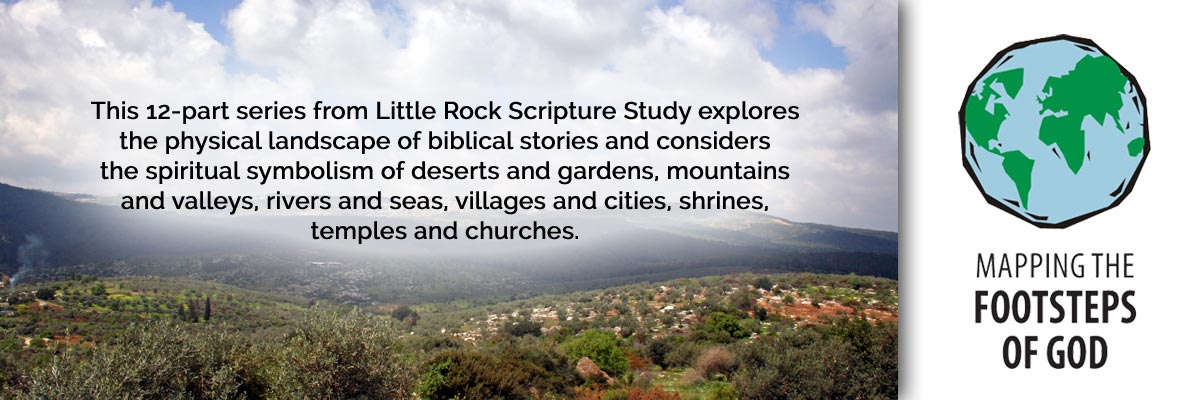Official Website of the
Catholic Diocese of Little Rock
Shrines remind us of God’s saving deeds
Published: October 25, 2014
This is the 10th column in a 12-part series.
By Clifford M. Yeary
Associate Director, Little Rock Scripture Study
The earth is a holy place, made so because the Creator found creation to be not only good, but “very good” (Genesis 1:31). Our world is complicated, however, by the evil humans have introduced. Our frequent incapacity to see the Creator shining through the gift of creation muddies our perception (but even mud is holy, for God made us from the clay of the earth). Thus, we call the world of our day-to-day existence “mundane,” that is, “worldly,” as if being worldly means boring or unexceptional.
 This leads us to hunt for an elusive sense of the sacred in the world. In the Old Testament, people of every nation tended to build shrines atop the rise of any hill or mountain. On these “high places,” the Israelites themselves worshiped not only the God of the Exodus (Yahweh), but also Baal and Astarte, the storm and fertility gods of the Canaanites (see 2 Kings 17:29).
This leads us to hunt for an elusive sense of the sacred in the world. In the Old Testament, people of every nation tended to build shrines atop the rise of any hill or mountain. On these “high places,” the Israelites themselves worshiped not only the God of the Exodus (Yahweh), but also Baal and Astarte, the storm and fertility gods of the Canaanites (see 2 Kings 17:29).
In Scripture it is God who does the real seeking, searching for a people who can be fashioned into a holy dwelling for his divine presence. Genesis tells us that God began seeking us at the very beginning, after our first sin, when we hid from the Lord in the garden of Eden (Genesis 3:8-9).
There are a number of sites which Israel preserved in memory and/or tradition as the locales associated with some of God’s special encounters with them. These include the Cave of Machpelah, Jacob’s well, Gilgal, the Tomb of David and the TempleMount in Jerusalem. Because of their association with people and events vital to salvation history they became shrines where religious pilgrims could come closer to God by recalling more experientially the mighty deeds of God.
Mount Sinai, where God revealed the Ten Commandments to Moses, did not become a religious shrine until Christians identified it with a particular mountain in the southern Sinai Peninsula.
When Abraham purchased the cave of Machpelah as a tomb for his wife, Sarah (Genesis 23:1-20), he was also establishing his first property rights in the land of Canaan, the land which God had promised Abraham to give in its entirety to his posterity (Genesis 17:8). Abraham was also buried there and it has remained a shrine to this day. It is located beneath an active mosque and while it is sacred to Jews as well, today only Muslims and Christians are allowed to visit.
The tribes of Israel first entered the Promised Land by crossing the Jordan River. Led by Joshua, they placed twelve large stones, one for each tribe, at Gilgal, their first encampment in the land. The stones were to remind future generations how God had led them to this place. Its actual location is now a disputed, speculative matter.
Jacob’s well, near the ancient site of Shechem, is not actually mentioned in the Old Testament, but Genesis 33:18-20 tells of Jacob setting up camp at Shechem. The well was known as such by New Testament times and it is the site of Jesus’ encounter with a Samaritan woman (John 4:1-42).
The Tomb of King David, located in Jerusalem, was never identified as such until 12 centuries after the birth of Christ, and its authenticity has been called into doubt by a number of archeologists. Its popularity as a shrine, however, remains unabated, in no small part because on its upper floor is the Cenacle, which is believed to be the upper room where Jesus celebrated the Last Supper with his disciples (Luke 22:7-22).
For Jews today, there is no holier site than the Wailing Wall, the western retaining wall at the base of what was the Temple Mount. The mount itself now includes two important Islamic shrines, the Dome of the Rock and the al-Aqsa Mosque.
The Gospels contain detailed accounts of Jesus’ ministry, his death and resurrection. Christian pilgrims to the Holy Land will discover that every site that can be associated with Jesus and his ministry, whether made an official shrine or not, will stir their souls with the sense of the Savior’s presence.
Paul’s letters and the Book of Acts have made many locations from the Middle East, through modern Turkey and into Greece and Italy, places to encounter anew the Gospel Paul first carried “to the ends of the earth” (Acts 13:47).
Study Questions
- What places have you visited that you regard as especially holy?
- What shrines (or holy places) would you especially like to visit, but haven’t yet?
- What is it, do you think, that makes a place other than a church, holy?
- Has visiting a shrine helped promote your own spiritual growth? If so, how did it influence your spiritual growth?
This article was originally published in Arkansas Catholic Oct. 25, 2014. Copyright Diocese of Little Rock. All rights reserved. This article may be copied or redistributed with acknowledgement and permission of the publisher.




